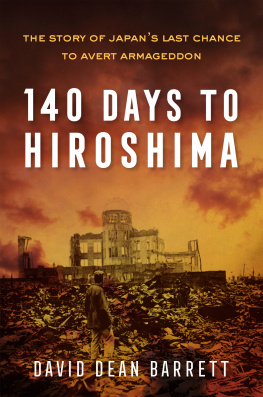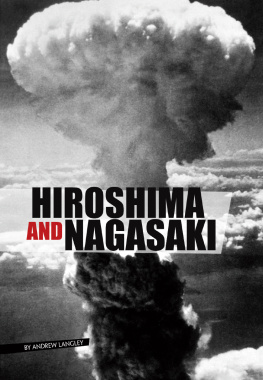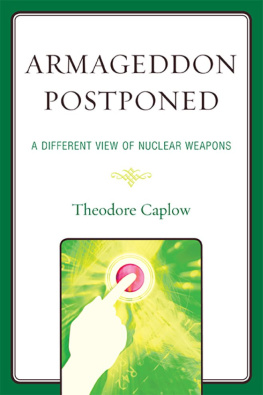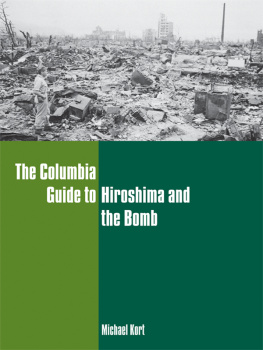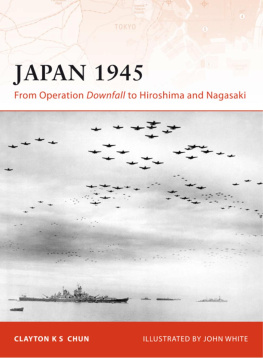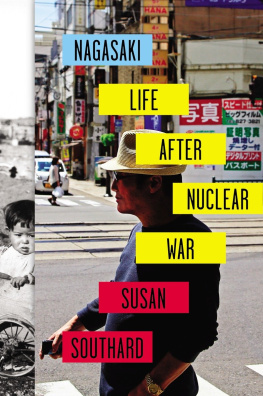
140 DAYS TO
HIROSHIMA


Copyright 2020 by David Dean Barrett
All rights reserved, including the right to reproduce this book or portions thereof in any form whatsoever.
Unless otherwise noted, all images are courtesy of John Blake Publishing.
For more information, email info@diversionbooks.com
Diversion Books
A division of Diversion Publishing Corp.
443 Park Avenue South, suite 1004
New York, NY 10016
www.diversionbooks.com
Book design by Janine Suarez for Neuwirth & Associates
First Diversion Books edition April 2020
Hardcover ISBN: 978-1-63576-581-6
eBook ISBN: 978-1-63576-580-9
Printed in The United States of America
1 3 5 7 9 10 8 6 4 2
Library of Congress cataloging-in-publication data is available on file.
Dedicated to all the American veterans who served during World War II
CONTENTS
AUTHORS NOTE
The common way for Japanese names to be displayed is first name last and last name first. Ive chosen to follow the more universal method of first name first and last name last.
PROLOGUE
By the summer of 1944, U.S. military power in the Pacific Theater had grown spectacularly. Beginning nine days after the D-Day invasion in France, American forces launched their largest attacks yet against the Japanese-held islands of Saipan on June 15, Guam on July 21, and Tinian on July 24. Situated 1,200 to 1,500 miles south of Japan, the crescent-shaped archipelago known as the Marianas was strategically important to the defense of the Empire, protecting vital shipping lanes from Asia and a widened aerial attack of the homeland.
Over the next sixty days, each of the three islands fell to the Americans. During grueling land and sea campaigns, U.S. forces killed 60,000 Japanese soldiers, sailors, and airmen, while the Japanese inflicted just under 30,000 total casualties on the Americans, killing 5,500.
On June 19 and 20, west of the Marianas in the Philippine Sea, the American and Japanese Navies fought one of the greatest air-sea engagements of World War II, the Battle of the Philippine Seaalso known as The Great Marianas Turkey Shoot. In the course of the two-day battle, American aviators decimated their Japanese counterparts, shooting down nearly four hundred aircraft. The additional destruction of three Japanese fleet aircraft carriers forever prevented Japan from using carriers to conduct offensive operations in the war.
The losses also made clear to Japans military leaders that there was no chance of victory; their only remaining options would lie within the terms of peace, if the Allies were willing to negotiate. With Japans failed defense of the Marianas, the war journal of Imperial Headquarters concluded in July of 1944:
We can no longer direct the war with any hope of success. The only course left is for Japans 100 million people to sacrifice their lives by charging the enemy to make them lose their will to fight.
In judging the situationthere is unanimous agreement that henceforth we will slowly fall into a state of ruin. So it is necessary to plan for a quick end to the war.
In the aftermath of battles, American Seabees (Naval Construction Force) transformed Saipan, Tinian, and Guam into some of the largest airfields in the world. By Thanksgiving, those bases were mated with the United States newest four-engine, long-range heavy bomber, the B-29 Superfortress, putting Japan squarely in the crosshairs of Americas strategic bombing campaign.
The fall and early winter of 1944 saw the fall of Peleliu, which was six hundred miles east of Mindanao; the invasion of the Philippines; the Battle of Leyte Gulf, the largest naval engagement in history; and the relocation of the strategic bombing campaign against mainland Japan from China to the Marianas.
As 1945 opened and the War in the Pacific entered its fourth and decisive year, the United States had fought its way across the vastness of the worlds largest ocean and had begun its assault on Japanese territory, but at an ever-greater cost. From the summer of 1944 to the wars end in August of 1945, America suffered nearly two thirds of its total Pacific War casualties, including over half of the men killed in action.
1
TOKYO BURN JOB
More than 70,000 men in the 3 rd , 4 th , and 5 th Marine divisions invaded Iwo Jima on February 19, 1945. In anticipation of the most intense ground fighting of the warwhat the U.S. knew would be a fiercely determined oppositionthe assault was supported by 800 ships and 220,000 naval personnel.
Located midway between the American B-29 bomber bases in the Marianas and the main islands of Japan, the tiny speck of volcanic earth was invaluable amid the vast Pacific Ocean, its runways representing salvation for crippled B-29s returning from bombing missions. Taking the island and eliminating its enemy radar station also deprived the Japanese of an early warning system for attacks on the home islands and eradicated the risk of any further attacks by Japanese planes against Guam, Saipan, and Tinian as well.
In the thirty-six days of combat it took to wrest the eight-square-mile island from its 20,000-plus defenders, 19,217 Americans were wounded and a further 6,822 killed853 men for every square mile. Japanese losses were nearly total.
The new air offensive from the Marianaswhich began in late November 1944was a huge logistical improvement over the India-China operations, but it remained ineffective. To take advantage of the newest, most sophisticated, and expensive heavy bomber in Americas arsenalthe B-29the bombs were being dropped from over 25,000 feet during the day. The bombs were often miles off target, primarily due to the persistent existence of the jet stream and cloud cover over Japan.
Things quickly changed when, on January 20, 1945, a rising star in the United States Army Air Forces, thirty-eight-year-old Curtis LeMay, nicknamed Old Iron Pants, took control of the XXI Bomber Command headquartered at Harmon Field on Guam. A veteran of nearly two years of aerial combat with the Eighth Air Force in England, LeMay had helped develop the combat box formation used over Europe. The configuration protected heavy bombers against fighter attack by maximizing the defensive firepower of all the .50 caliber machine guns of the planes in the formation, while at the same time concentrating the bomb pattern on the target. Future Secretary of Defense Robert McNamara described LeMay as the finest combat commander of any service I came across in the war.
Sent to the Pacific to produce results, throughout February and into the first week of March LeMay and his staff worked on plans that radically altered the XXIs bombing tactics. No longer would the B-29s bomb from high altitude. Instead they would fly at less than ten thousand feet, under the cover of darkness. The lower altitude reduced the amount of fuel required for missions while also easing the stress on the planes finicky R-3350 engines. And in an extreme effort to reduce all possible weight, all the B-29s .50 caliber machine guns were removed, except for the twin .50s in the tail of the plane. Less weight translated into bigger bomb loads.
The B-29s primary weapon would be the M69 incendiary bomblet. Nicknamed Tokyo Calling Cards , M69s were hexagonal steel cylinders three inches in diameter and twenty inches long, weighing 6.2 pounds. Each bomblet contained Napalm-B encased in cheesecloth as its incendiary filler. The improved version of napalm included newly added polystyrene and benzene, which yielded a longer-burning fire at temperatures up to 2,000 degrees Fahrenheit. Thirty-eight of the bomblets were enclosed in a finned E-46 aimable cluster. The cluster opened at a designated altitude, typically 2,000 feet, and would spread its munitions across a 500 feet by 2,500 feet swath. Each of the M69s had a three-foot-long cotton streamer, resembling the tail of a kite, to orient its fuse downward, control the velocity of descent, and spread the munitions as they dropped to the target. After hitting a building or the ground, the timing fuse burned for three to five seconds before detonating a white phosphorous charge. The explosion propelled flaming globs of napalm up to a hundred feet, instantly starting intense fires. A typical bombload for a B-29 included forty cluster bombs or 1,520 M69 bomblets.
Next page
